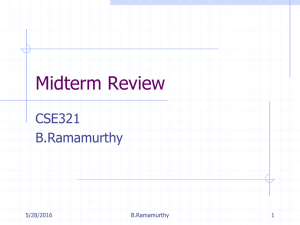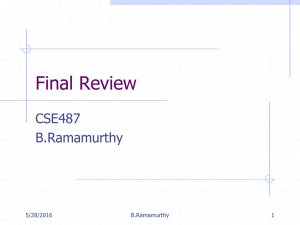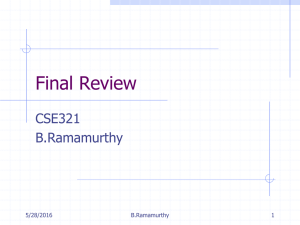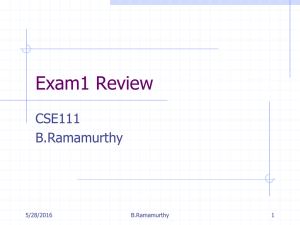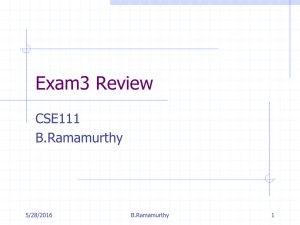Distributed System Using Java 2 Enterprise Edition (J2EE) B.Ramamurthy
advertisement
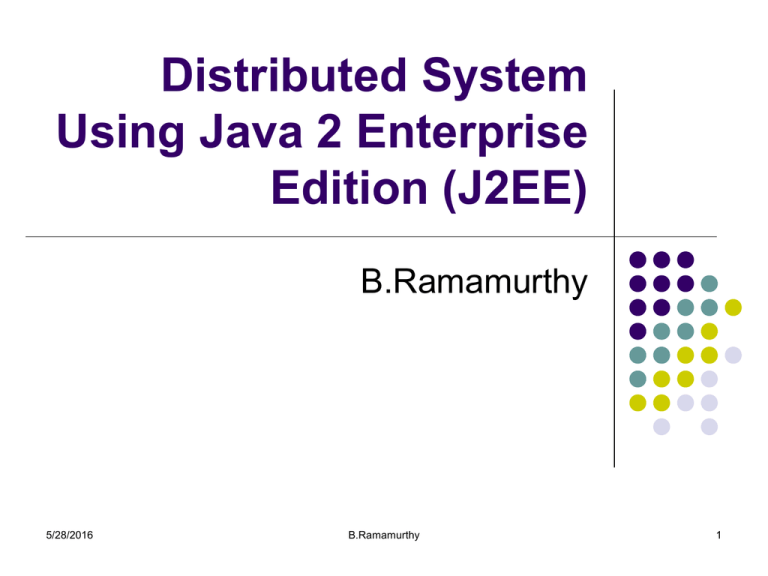
Distributed System Using Java 2 Enterprise Edition (J2EE) B.Ramamurthy 5/28/2016 B.Ramamurthy 1 Introduction Sun Microsystems provides specifications for a comprehensive suite of technologies to solve large scale distributed system problems. This suite is the Java 2 Enterprise Edition, commonly known as J2EE. In this discussion we will discuss the architecture of J2EE and how it can be used to develop distributed multi-tiered applications. This discussion is based on the tutorial by Sun Microsystems Inc. 5/28/2016 B.Ramamurthy 2 J2EE Suite Core technology: Container infrastructure, language and environment support XML technology Web Technology The Java API for XML Processing (JAXP) The Java API for XML-based RPC (JAX-RPC) SOAP with Attachments API for Java (SAAJ) The Java API for XML Registries (JAXR) Java Servlets JavaServer Pages JavaServer Pages Standard Tag Library Enterprise Java Bean (EJB) technology Session beans Entity beans Enterprise JavaBeans Query Language Message-driven beans Platform services 5/28/2016 Security Transactions Resources Connectors Java Message Service B.Ramamurthy 3 Distributed Multi-tiered Applications Services, clients (people and application) and data are distributed geographically across many platforms and many machines. Multiple tiers: 5/28/2016 Client-tier (browser or client-application) Web-tier (web-server: Java Server Pages) Business-tier (logic; Examples: Enterprise Java Beans) Enterprise-Information-System (EIS) tier (database) B.Ramamurthy 4 J2EE clients Web clients Dynamic web pages with HTML, rendered by web browsers. Can include applets. Communicates with server typically using HTTP. Application clients 5/28/2016 User interface using GUI components such as Swing and AWT. Directly accesses the business logic tier. B.Ramamurthy 5 Web-tier Components Client can communicate with the business tier either directly or through servlets ot JSP that are located in the web-tier. Web-tier can help in pre-processing and allows distribution of the functionality. See Figure 2-1 Servlets are special classes to realize the requestresponse model (get, post of HTTP). JSP is a developer-friendly wrapper over the servlet classes. 5/28/2016 B.Ramamurthy 6 Business-tier Components This is defined by the logic that pertains to the (business) application that is being developed. Enterprise Java Beans (EJB) can be used to implement this tier. This tier receives the data from the web-tier and processes the data and sends it to the EIS-tier and takes the data from the EIS and sends it to the webtier. See Figure 1-3, and Figure 1-4 5/28/2016 B.Ramamurthy 7 Enterprise Java Beans Session beans Entity Beans Bean-managed Persistence (BMP) Container-managed Persistence (CMP) Enterprise Javabeans Query Lanaguage Messaging Bean 5/28/2016 Session bean with Java Messaging features B.Ramamurthy 8 Session Beans For transient functions Represents “conversational” state Typically one per request Data is non-persistent Lifetime is limited by the client’s: once the client exits, the session bean and data are gone. Simple and easy to program. Light-weight. 5/28/2016 B.Ramamurthy 9 Entity Bean “Transactional” in behavior Can be shared among clients Persistent: data exists permanently after client quits. Corresponds to a row a relational database. The persistence (storing into the database) can be automatically done by the “container” (CMP) or explicitly by the bean (BMP) 5/28/2016 B.Ramamurthy 10 Enterprise Information System (EIS) Tier In general this corresponds to the database (relational database) and other information management system. The other information management systems may include Enterprise Resource Planning (ERP) and legacy system connected through open database connectivity. 5/28/2016 B.Ramamurthy 11 Container Services A container interfaces the programmatic components such as EJBs to the declarative components. Container services include security, transaction management, naming services, and remote connectivity. The fact that the J2EE architecture provides configurable services means that application components can behave differently based on where they are deployed. The concept of “deployable units” and “containers” where they can be deployed is central to J2EE. 5/28/2016 B.Ramamurthy 12
